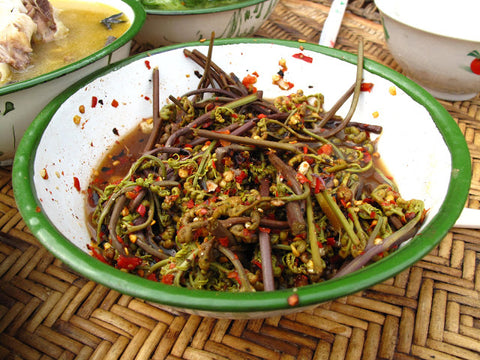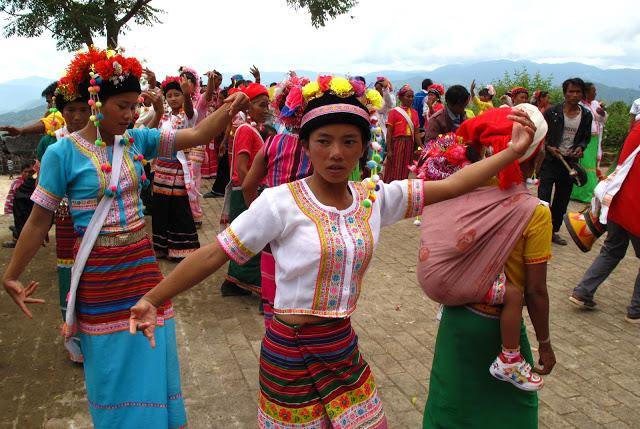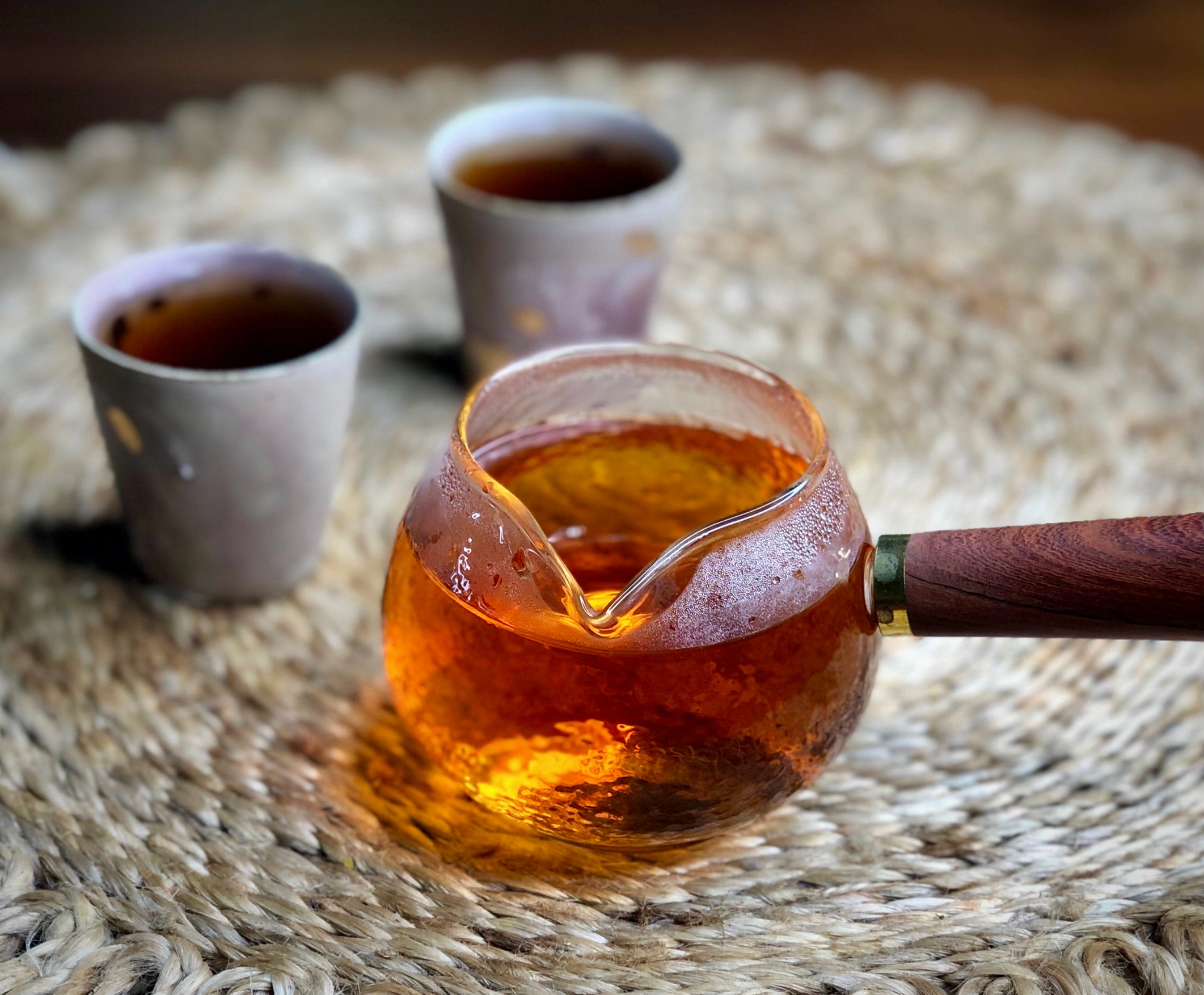
Open Door festival in Jingmai - Autumn 2011
We arrived in Jingmai 景迈 just in time for the traditional Door-Opening Festival 开门节, a time of year when work stops, young couples get married, and families repair their homes.
We rose early in the morning to view the "sea of clouds" 云海 - this happens so frequently the locals are rather blase about it, but for us city slickers, waking above the clouds filled us with great excitement and a feeling of adventure.

景迈 云海 - Good morning Jingmai!
As the sun warmed the valley, the blanket of clouds slowly expanded and rose up the mountain side, enveloping the whole village. It was a truly wondrous & magical scene. Watching people go about their daily lives, surrounded in mist, I felt I had climbed to the top of Enid Blyton's Magic Faraway Tree.

Climbing up above the village, we found remnants of the "old tea horse road" 茶马古道 heading into Burma. Large flagstones form rough steps up the mountain, next to new wooden steps built for tourism. Currently Jingmai is one of the most beautiful places to source puer. It's relative remoteness, a full day's drive from Lincang or Banna, means it is still relatively rustic & charming. The government has poured billions of yuan into this region of Simao, beautifying it as an eco-tourism destination. The roads are noticeably better than neighboring prefectures, and there is a brand new dam supplying Jingmai with fresh water. In just a few more years they will open an airport in the valley below. So visit now, before the tourist hordes arrive & ruin everything.

Jingmai's Cha Ma Gu Dao 茶马古道
Our Jingmai tea is sourced from Da Ping Zhang 大平掌, the most expensive tea garden on the mountain, with the oldest & largest trees, growing 1,700m above sea level. The trees are clearly ancient, many split & rotted in the middle, covered in lichen & epiphytes, and crawling with colorful bugs & spindly daddy long legs. Have you ever seen a tea tree absolutely teeming with daddy long legs? It's hard to photograph, but then again you don't really need to, as it's one of those bizarre memories that will stay with you for life.

Imagine hundreds of these guys doing the hoodoo
Hidden amongst the branches of the tea trees is the highly prized "pang xie jiao" or "crab pincers" - a parasitical plant local to Jingmai. It's quite hard to spot, as it grows in small sprigs, and prefers the branches of older, taller trees. The tea pickers will harvest any they come across, and dry them in the sun. Pang Xie Jiao is prepared as a herbal infusion, sometimes brewed with puer. It is known for its cooling properties, and for visiting constipated city folk, has the happy side effect of inducing immediate diarrhea. Quite handy really.

Parasitical crab pincers 螃蟹脚 “pang xie jiao"
In Autumn the tea forest is lush and verdant. In Spring, the farmers plough the undergrowth back into the soft red soil, to save water, but also to make tea harvesting easier by removing grass & insects. The exposed topsoil is surprisingly fine & dusty, cascading away as you tramp up the steep slopes.

Da Ping Zhai tea garden in Autumn 2011 - lush & green

Da Ping Zhang in Spring 2012 - note the dusty red ground!
Most of the tea trees in Da Ping Zhang are between 3-5m in height, but there are a few towering giants like this one!

The "king of trees" in Da Ping Zhang
If tea trees are not pruned, they tend to grow straight up seeking the light. So it is common practice to crop the vertical branches, so the tree offers more horizontal branches, creating a sturdy platform to clamber up and stand on whilst picking.

Tea tree pruned for easier harvesting - Autumn 2011

Tea picker in the canopy - Spring 2012
Cheaper "sheng tai" (生态 naturally grown) tea can also be seen growing in large plantations on the lower slopes of the mountain (1,000 -1,700m elevation). These enormous plantations are owned by Brilliant group (柏联集团), who also own the 5 star hotel & spa down in the valley. I suspect they got a good deal on the land in return for developing it into an eco-tourism attraction. They have far less shade trees and biodiversity than Da Ping Zhang. In recent years, two out of every three bushes has been removed, to convert the plantations from "tai di" (high intensity terrace plantation) into "sheng tai". They no longer use of pesticide or chemical fertilizer here, but the freshly picked leaves are all processed by machine. The cheaper cakes you see on the market are made from this "sheng tai" maocha. It tastes slightly thinner and weaker, compared to the gushu tea from Da Ping Zhang, which has a fuller body, with more spice, complexity and kick.

"Naturally grown" tea plantations on the lower slopes of Jingmai
It may not be gushu, but it's still beautiful. Driving up over cobblestone roads, through the plantations to reach Jingmai Da Zhai, you can't help but feel one day this will be Yunnan's equivalent of the Bordeaux region of France.

Beautiful painted doors to the old Buddhist Temple in Jingmai Da Zhai
We stayed in Jingmai Da Zhai - the "big village" of Jingmai, where there are two hundred households, gathered around two Buddhist temples, staffed by monks from Myanmar. Colourful baskets covered the ground, as the village elders gathered round to share food and exchange stories of their families.

Hand painted baskets in Jingmai
The food in Jingmai is fantastic. We picked tender young "fiddlehead" shoots of wild fern from the forest floor which were then cooked up for lunch. There are two kinds of fern shoots, they look identical to the untrained eye, yet only one kind is edible.

Fern shoots & chilli
Our host's wife nimbly clambered up a 15m high tree to pluck these tiny, extremely sour plums, which were served with chilli.

And what a special treat to wake up to a breakfast of fried tea leaves & free range eggs! The villagers here truly live off nature's supermarket!

Fried tea leaves & eggs
We also ate wasp larvae during the Open Door festival.
There are only two workshops that are skilled at hand processing maocha in Jingmai. We partner with a young Dai man called Ai Zai Yi, who was introduced to me by Korean tea adventurer Chong Kyong Won. At the time we first met, Ai Zai Yi was only 23, married with his first kid, and studying hard to learn English.

Ai Zai Yi's wedding photo

Ai Zai Yi
Ai Zai Yi's customers come from all over the world, and have awakened in him, an ambition to travel. He badly wants to learn English and repeatedly practices his limited vocabulary of "Hello! How are you today?" and "Welcome to my home. Welcome to beautiful Jingmai!" He even plays english tutorials on the CD player in his truck. His home is a rudimentary wooden long house, but with a difference, he has paid a small fortune to get wireless internet. He tries to improve his English by chatting with foreigners online. I admire his determination to transcend village life, so far it's made him the best puer producer in Jingmai village, I hope it will take him further.
Unlike most young men in the tea business, Ai Zai Yi does not smoke, and even avoids alcohol as much as possible. When I ask him why, he says it's his father's influence. Ai Zai Yi is lucky to have such a great dad. Not only is he funny, he is fearless. He slaughters & butchers pigs for a living, and during tea picking season, can be seen scaling the tallest trees. He jokingly tells us "The only thing I'm scared of, is getting sick!" because that would stop him doing fearless things. Yet he was originally opposed to Ai Zai Yi starting a tea business. But Ai Zai Yi had a mind of his own, and travelled to distant Yiwu to study how they make maocha. Yiwu is highly regarded in Yunnan as the place with the best technique. Thanks to his skill at hand-processing tea, he now has a thriving workshop under his house, where he employs his friends & relatives and teaches them how to process puer. We cooked under his house on two large iron woks. It takes two people to fry, as the wood fire underneath needs to be carefully controlled to maintain the right temperature. Fittingly, pruned tea branches are used for fuel.

Yours truly feeding the fire
It's not just a matter of putting branches in, you have to move them around, and pull them out to keep a constant temperature across the entire bottom of the wok. Ai Zai Yi can tell just from the sizzle of the leaves, whether the temperature is too high or low.

Sha Qing - wok frying to kill green
When frying the leaves, a basket is pressed against the stove, not to protect against the heat, but to stop valuable leaves from escaping the wok as you scoop leaves towards you. With a deft flip of the wrists, the leaves are spun back onto the hot side of the wok. The heat of the wok is intense, causing fingers to blister, despite the thick gloves, but the aroma of frying leaves is so delicious and intoxicating, you don't feel the pain until later.

Rou Nian - Rolling the leaves to mix the leaf juices
After frying, the leaves are spread out so they don't stick together, and allowed to cool slightly before rolling. This involves forming a ball of leaves and applying gentle pressure as you roll the ball around, spreading your fingers to gather more leaves into the ball. It's a little like kneading dough. When all the leaves have been rolled to an appropriate degree, they will feel rubbery, sticky & fragrant. We then spread them out evenly on a mat, ready to be sun-dried. Typically this occurs the next day. We pray we get a full day of strong sunlight, to bring out the best in our maocha.

Ready to be sun dried into maocha
After the maocha is dried, it is gathered in sacks, ready for hand sorting. The whole family lends a hand picking out older, discolored leaves. Even with so many helping hands, it takes the better part of an afternoon to work through a 10kg sack.

Sorting the dried maocha
There's something magical about drinking fresh maocha, the day after processing. It's incredibly green, with a rhubarb like vegetal taste & spicy nose. After closed fermentation in airtight plastic bags for a month, the maocha will have developed a fuller taste & fragrance. It is at this stage that we steam & press it into cakes.

Tasting the fresh maocha
We did not press any Autumn 2011 tea due to the overcast weather, but we were lucky to have a week of good sunshine when we visited in Spring 2012 and we pressed 30kg of Jingmai single grove Da Ping Zhang gushu, picked on April 2nd and 3rd, from trees owned by Ai Zai Yi, his sister, brother & aunty. The fresh leaves were hand processed by Ai Zai Yi himself. You can order our 2012 Spring Jingmai from the Tea Urchin online shop.

Tea Urchin 2012 Spring Jingmai 357g cake

